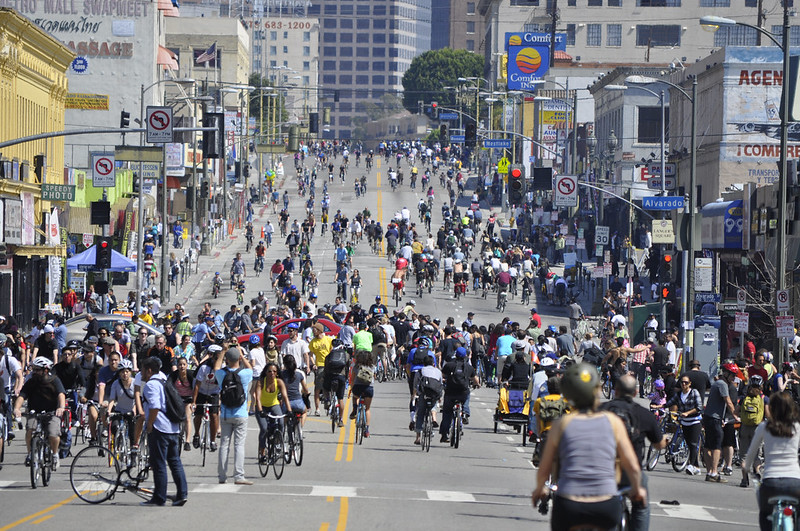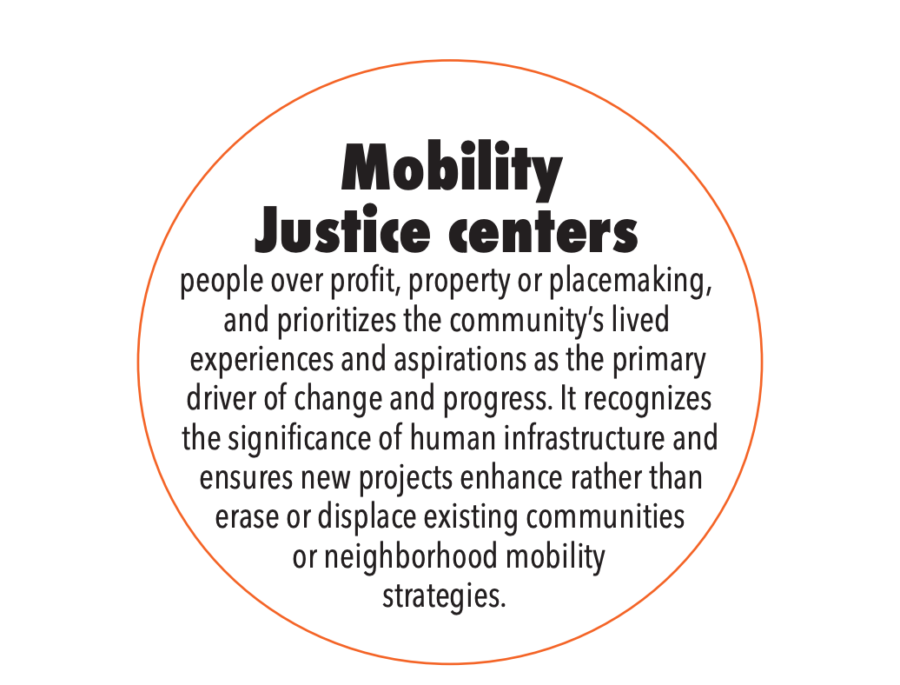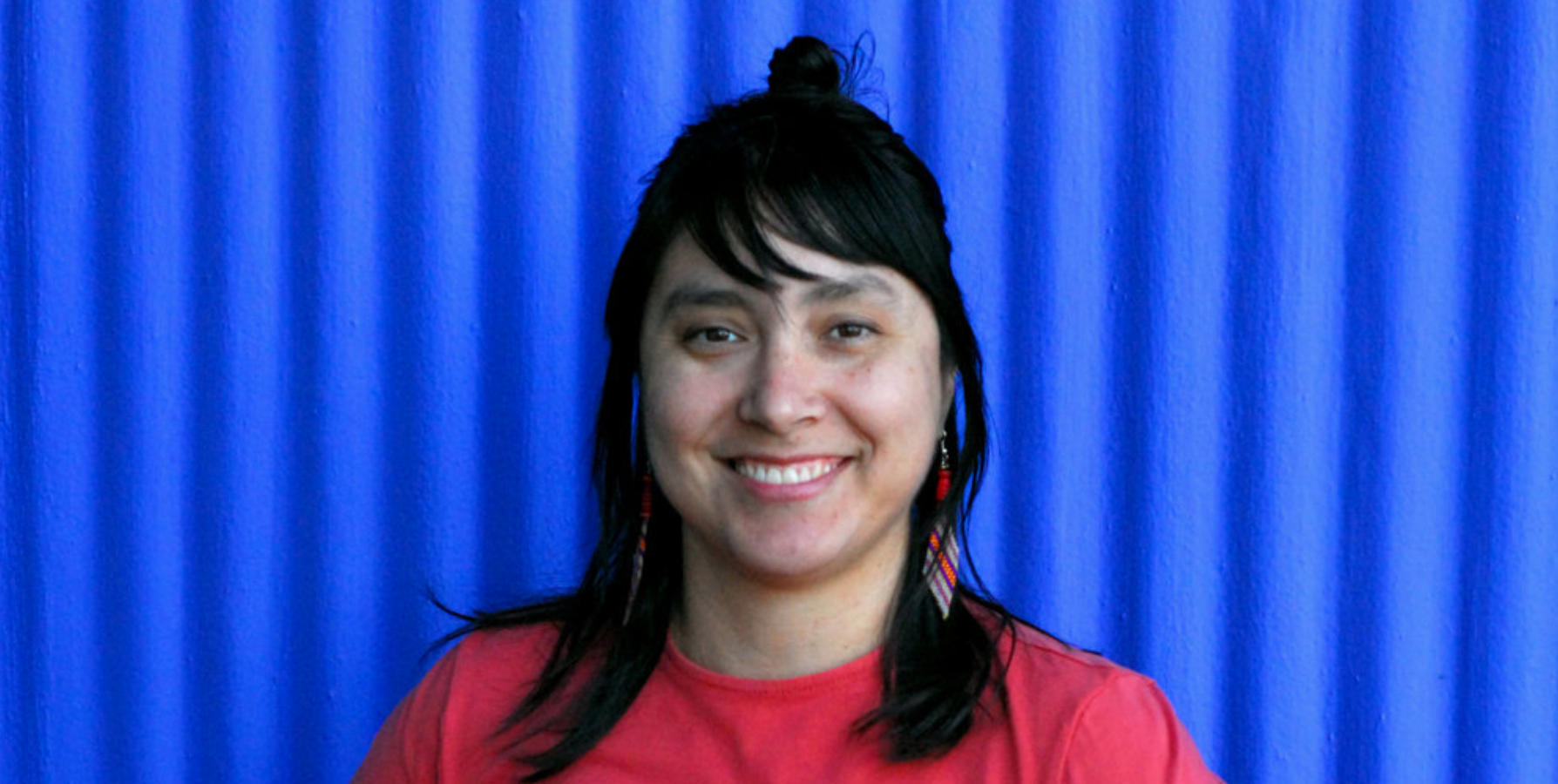11 min read.
Dr. Adonia Lugo is an urban anthropologist and mobility justice strategist based in Los Angeles. She is also the Interim Chair of the MA in Urban Sustainability (USMA) at Antioch University Los Angeles. Adonia is a leading voice in envisioning a sustainable transportation future centred in the needs and experiences of historically marginalised communities and people of colour.
How did you become involved in bicycle advocacy?
I first started being a bike commuter in Portland, Oregon, which is a city known in the USA for promoting bicycling as a mode of transportation. When I moved back to Southern California I became interested in why it felt so different to be riding my bike in LA county as opposed to how it had been in Portland, and I started making connections with my earlier childhood experiences as well as the street culture in Southern California. A starting point was in 2008 when I attended a community engagement session by the local planning department in Long Beach about a proposed bicycle project on a street close to the ocean. I was so surprised to learn that some of the people there were really opposed to having such a minor, pro-human project done on their street. I came to understand that there was hostility to bicycling because some people there associated bicycling with poor people, homeless people, people of colour, generally people they didn’t want in their neighbourhood. On the other hand, there were people involved in bicycle advocacy, and this was my first experience with such networks trying to promote bicycling.
The summer of that same year, I also visited Bogota, where I experienced the Ciclovía, and spoke to one of the creators of this open street event, Jaime Ortiz Mariño. I also visited NYC, Washington DC, Atlanta, Chicago, and this exposure to different urban contexts helped me to develop my understanding of what made LA unique in terms of street culture. Upon my return, I started getting involved with the LA County Bicycle Coalition and other local projects. I also learned about bicycle advocacy through websites like Streetsblog, the dynamic online conversation about promoting bicycling, as well as in gatherings like the World Car Free Cities Conference.
You were among the founding members of the group that made CicLAvia possible in LA. Can you speak to how this project came to be, and its significance for the city?
I was very excited about the Ciclovía concept because from a cultural anthropology perspective my lens on transportation was more about people and culture, whereas in advocacy there was a very strong focus on the power of the built environment to change people’s behaviour. The Ciclovía represents something different. It’s an activation, an intervention that temporarily changes how we use a space but not its physical shape.
I also found that in Bogota, there were lots of typological and cultural similarities with Los Angeles. When we formed a committee to organise what we named CicLAvia, and I had a strong sense that the cultural familiarity of the Ciclovía was going to make it successful in LA. In other cities experimenting with open streets in the USA, they had stripped away those cultural elements, whereas in LA the event here really fit with the street culture. The other key element was the existence of a thriving ecosystem of group rides in LA, for example through groups like the Midnight Ridazz. Every night of the week there were groups of young people on bicycles. It made sense to try and grow this energy into a city sponsored event that meshed the Latinx multiracial public culture of LA and the ongoing excitement about riding bicycles as being a radical and creative act.

In a lot of bicycle advocacy circles, the benefits of bicycling are often framed around sustainability, or health – but for many communities the bicycle is simply the most accessible, affordable mode of transportation. Could you speak to how these communities are often underrepresented in the bicycle discourse?
Another starting point for me, before even getting into bicycle advocacy, was the death of a Mexican immigrant who was riding a bicycle in the fall of 2007 and killed in the suburbs near where I grew up. This was the kind of bicycling that I was concerned about, that I could see. There were lots of working people using bicycles, and I questioned why they weren’t safe. Initially I was in a different category, a so-called hipster with a road bike used for commuting even though I had access to other transportation choices. Having grown up in an immigrant neighbourhood however, I was very aware of the hardships, sacrifices and emotional strain people are under in these communities. Why was it so dangerous for them to travel on top of this ?
This was not the common perspective in bicycle enthusiast circles because they were approaching cycling from a different understanding. My dual experience of living across the boundaries in a racially segregated society allows me and other people of similar backgrounds to see streets in multiple ways, that people of more privileged backgrounds are trained to not see, and even if they do, don’t integrate it in their vision of what’s good for the city. I came to understand over the years that most people in the USA that are using bikes for transportation do so because they have no other choice, but they are not being represented in bicycle advocacy circles. These circles are run by passionate, personally motivated, enthusiasts who often have humanitarian goals. What I learned however is that just because somebody is confronting and recognising injustice in a particular context, they are not necessarily positioned to see how that fits in a broader landscape of injustice.
People who were promoting bicycling simply didn’t see how it fit into realities of economic injustice, persecution of immigrants, racism, and transportation injustice. A lot of the work I’ve done over the years is to try and raise awareness about those realities, and work in partnership with others who have this perspective, that come from more marginalised communities, and are concerned about the greater burden on people of colour. We had a really tragic incident in LA County last month, where an unarmed Black man was gunned down by police. They had stopped him for riding a bicycle in the wrong direction on a street. We need to make a connection between who is being protected on our streets and how it confirms the claims of Black Lives Matter around the persecution of Black bodies. It is so clear that for people who care deeply about reducing vehicular violence, it is taken for granted that traffic safety laws are a good thing and that enforcing them is a good thing, but with police violence we are starting to question whether traffic safety models work when a large numbers of deaths start at traffic stops. For too long, bicycle groups have assumed that police are our partners but we may need to start rethinking that.

In your book Bicycle/Race: Transportation, Culture and Resistance, you address the overwhelming focus of the bicycle community on physical infrastructure, and you apply the concept of “Human Infrastructure” to bicycling. What this term means in the context of your work, and how it can fill a missing piece in the bicycle discourse ?
Bicycle advocacy circles rely on having a shared culture, a sense of community, camaraderie and fun, and yet in LA for example they weren’t going to the city looking for funding for group rides, community bike shops or earn a bike programs for youth so we could bring in more people into this culture we were building. They were going to the city and trying to make changes within the department of transportation on road design and updating the city’s bicycle master plan. Having witnessed this big emphasis on the built environment and environmental determinism to try and get more people to feel safe on bicycles, the Human Infrastructure concept to me was a way to talk about the cultural element that people seem to be overlooking. It programmatically made sense to borrow that concept and bring it to urban transportation.
What I’ve seen over the years is there has been a fair bit of resistance to even talking about it, because there is a sense of life-death urgency and that produces a homogeneity. It also reflects a relatively homogenous bicycle advocacy space in terms of gender, class, race, so new ideas were not necessarily welcome. Coming from an academic standpoint as an engaged participant, I was bringing to light a cultural dimension. When I started working in Washington DC for the League of American Bicyclists, they weren’t interested in new ideas and felt challenged. People felt like I was attacking the infrastructure model and over the years people have asked me “why don’t you like infrastructure”. They saw it as an either or, but there is no secret, magical formula for social change, we need to have multiple strategies. I think there needs to be more awareness of the role that culture and social attitudes play as well. So that’s what I meant to bring into the conversation with Human Infrastructure, and it resonates with many people all over the world.
There are multiple ways of using the street and this concept might be an avenue for people to change how they think of them; through events, and building cultures of cycling. In the USA, there is an industry of promoting bike lanes, planning firms that get government contracts to design and create these pieces of infrastructure, and they don’t have much incentive to promote more cultures of cycling driven change. It’s also been hard for bicyclists to see their own culture and their privileging of certain forms of culture. The fetishisation of northern European cities is for example also tied to a history that needs to be looked at and questioned. Part of using the Ciclovía model was an anti-imperialist vision of going beyond Eurocentric thinking. Bike infrastructure gets decontextualised too much in the US. Bike enthusiasts go to Northern European cities and see less toxic traffic culture and instead of thinking of socialist policies and strategies to combat social inequalities that might be at play, they think it has to do with street design. So they promote those concepts to US city governments but leave out the whole cultural and historical context.
You are also an organiser for a group called the Untokening, that has worked on defining principles of mobility justice. Can you elaborate on this concept of mobility justice and some of the core principles behind this initiative?
The Untokening collective came together as a result of a growing network of bicycle advocates of colour who had encountered friction when having been invited to help change white-led organisations or that felt stalled or pushed out by these organisations. The way we came together was the result of organising that had been happening since the 1990s from Black cycling clubs around the country. There has been a growing network of Black or multiracial recreational cycling clubs who started building this conversation and connected with advocates working within urban transportation. By 2013, there was a growing understanding of the need to shift in bicycle advocacy strategy, and see bicycling as part of a broader urban transportation landscape that connected to things like housing, economic opportunity etc. We started using the concept of mobility justice at our first convening of the Untokening in November 2016, because we were looking to describe our shared concern in a way that hadn’t been co-opted yet. A lot of us had been using the term transportation equity, which refers to more resources going to communities that had been harmed more but we felt that it had been watered down as a concept.
The core tenets of mobility justice have to due with the fact that as people are moving in streets and public spaces they are not outside of other structural racist, classist, masculinist frameworks, so the built environment is one component of how safe people will be but policing, harassment, crime, persecution of immigrants are all also need to be factored in. We want to get across that there is more to traveling around than what transportation planning usually looks at. Interestingly, a couple of years later, I spoke to a sociologist named Mimi Sheller who had also looked at this concept in her own way. When we connected, she was on the tail end of her book and there was so much overlap between the critical theory she had been developing and the work we were doing at the Untokening in the field of transportation planning. As an academic and participant in this work I feel really lucky that I get to help understand where there is crossover in this conversation.
Some key elements in our principles thus have to do with reexamining what we mean by street safety and connecting it with broader questions of public safety, following the lead of the BLM movement, recognising systemic harm done by public safety models, and even how everyday urban mobility ties in with migration and the movement of people across borders. As you are riding your bike in a city you are not separate from that global context, as so many people are carrying that with them. Furthermore, when we started mobility justice formulations/discussions within the Untokening we were very weary of the harms of gentrification and urban displacement, so we had an understanding that part of mobility justice was also the ability of staying in place. Mimi Sheller develops this really well, highlighting that there are kinetic elites that get to move as much as they want and others that are stuck and can’t move, and on the other hand there are those that are displaced and forced to move when they would like to stay safe at home but can’t because of war or economic violence. So the mobility justice concept as we are using it with the Untokening is continuing to evolve. It’s not a checklist, more of a conversation instigator. Mobility justice is a very local concept and it’s going to mean different things in different places.

Header photo by People for Mobility Justice.

